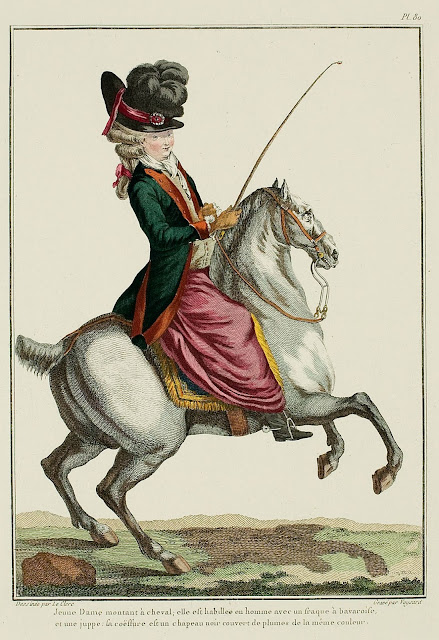Galerie des Modes, 21e Cahier, 1ere Figure
Young Lady riding a horse. She is dressed en homme with a frock coat with bavaroises, and a petticoat. Her coiffure is a black hat covered with feathers of the same color. (1779)
 AMAZONIAN DRESS, worn by Women of quality. Before the Carrosses* had been imagined in France, and had multiplied to the point that we see them today, Ladies who frequented the Court were used to make their rides sometimes alone, sometimes pillion. One can see the traces of this fashion in the last volume of Monumens de la Monarchie Française, by Benedictin Montfaucon. This fashion was not as particular to the French Ladies.
AMAZONIAN DRESS, worn by Women of quality. Before the Carrosses* had been imagined in France, and had multiplied to the point that we see them today, Ladies who frequented the Court were used to make their rides sometimes alone, sometimes pillion. One can see the traces of this fashion in the last volume of Monumens de la Monarchie Française, by Benedictin Montfaucon. This fashion was not as particular to the French Ladies.Brantôme, in speaking of Christine of Austria, niece to Charles V, first Duchess of Lorraine, then Queen of Denmark, recounts "that she rode very well and with very good grace, and would always ride l'étrier sur l'arçon,** which she taught to the Queen Marie (of Austria), her aunt: and I say truly, that the Queen mother (Catherine de' Medici) had taught it to her; for, previously, she would ride pillion, which certainly would show neither grace nor the beautiful gesture, as using the stirrups would."
This author adds "that this Princess never rode but on Spanish, Turkish, and Barbary horses, and handsome jennets, which went at an amble; altogether I have seen her to have for a favorite a dozen very beautiful horses, that one had to say each was more beautiful than the next."
 An illustrious Sovereign, the flower of her time, and of the same family, has brought back to France this ancient costume, which is also accredited at Court. It is the renewal of this fashion which is shown in the first Print of this book.
An illustrious Sovereign, the flower of her time, and of the same family, has brought back to France this ancient costume, which is also accredited at Court. It is the renewal of this fashion which is shown in the first Print of this book.The friendly Squire that is presented is dressed in a Frock coat with plain revers, basques pulled back in Military style, the sleeve parements like a Bishop's mitre or in Cavalier style; the gilet à la Chartres, crossing on the side and containing the cuirass. Kerchief en cravate. Petticoat à la Strade, open in front; soft boots, with high heels armed with spurs. Chignon braided in a cadogan, with two finger curls, and above this, a hat with a panache.
Young and graceful Duchesse de la Rochefoucault, is it necessary that we have to regret that this agreeable fashion cut short your life! Your courser, frightened, threw you, and your foot, unhappily caught in one of the stirrups, has caused your loss.
Let us turn our regards from this sad spectacle, which renews our sadness, and let us form a wish that this fashion may not be more fatal to the young Deities who want to adopt it. Maybe one should hope it will be abandoned. An amiable Woman is a being too precious not to excite her to flee all that could furnish the occasion of shortening her days.
We end this article by observing that it is surprising that some ingenious Artist hasn't been tempted to imagine the stirrups, whose combinations would prevent accidents like that which happened to the Duchesse de Rouchefoucault, and of which Men could be as easily the victims as Women.
* a type of carriage
** probably "astride"






Comments
Post a Comment